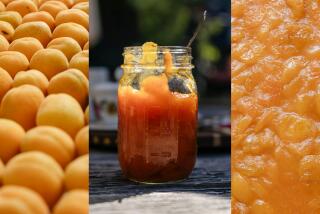Jammin’ : Can Do
- Share via
Few of us have hours to spend in the kitchen “putting up” food, but making a few jars of jam isn’t nearly as time-consuming as you might think. With the right equipment on hand, you can preserve a batch in a couple of hours.
To assure it remains safe to eat, all jam must be packed in standard glass canning jars with two-piece vacuum lids and processed in a water bath canner. This is a large kettle with a rack that fits inside to hold the jars separated and off the bottom so heat can penetrate properly.
Through the process of canning, heat destroys potentially harmful microorganisms and enzymes. At the same time, a partial vacuum is formed and the jars seal, preventing recontamination of the food inside.
The following basic information has been compiled using the “Ball Blue Book--The Guide to Home Canning and Freezing” and publications on canning from the U.S. Department of Agriculture.
Check the canning jars to see that they are free of chips, cracks or defects. Wash the jars and closures in hot soapy water and rinse well. Then place the jars in the water bath canner (without the rack), cover with water and boil 10 minutes to sterilize. Turn off the heat, but leave the jars in the hot water until needed.
Place the lids and bands in a small saucepan. Add water to cover, bring to a simmer, then remove the pan from the heat and let the lids and bands remain in the hot water.
Using tongs, remove one jar at a time from the canner. Ladle in the jam (Step 1), leaving 1/4-inch head space (this is the air space between the jam and the top of the jar) to allow for expansion of the jam while it is being processed.
Wipe the rim and threads of the jar with a clean, damp cloth (Step 2), then place the vacuum lid so the sealing compound is next to the jar (Step 3). Add the band (Step 4), screwing down evenly and tightly.
As each jar is filled, stand the jar in the rack of the boiling water bath canner (Step 5). When the rack is filled, lower into the canner (Step 6).
At this point the water in the canner needs to be hot, but not boiling, and should cover the jars by one to two inches. If it doesn’t, add more hot water.
Cover the canner and bring the water to a boil. Begin counting the processing time when the water reaches a full boil. Adjust the heat to maintain a steady boil. If the water boils away during the processing time and exposes the tops of the jars, add more boiling water to maintain the proper level.
When the processing time is completed, remove the jars from the canner and stand on a clean cloth or towel with space between them for air to circulate. Do not re-tighten the jar bands.
After 12 to 24 hours, check the seal on each by trying to push down on the lid center. If it depresses but springs back, the jar is not sealed.
If the lid is not already concave but holds when pushed down, the seal is questionable. Remove the screw band and carefully lift the jar by the edges of the lid just a fraction of an inch. If the lid comes off, the contents should be reprocessed using a new metal disk with sealing compound.
Before storing, remove the metal bands from the sealed jars. Be certain the jars are clean and labeled with the contents and date. If stored in a dry, dark, cool place, preserves should remain in optimum condition for a year.
More to Read
Eat your way across L.A.
Get our weekly Tasting Notes newsletter for reviews, news and more.
You may occasionally receive promotional content from the Los Angeles Times.







